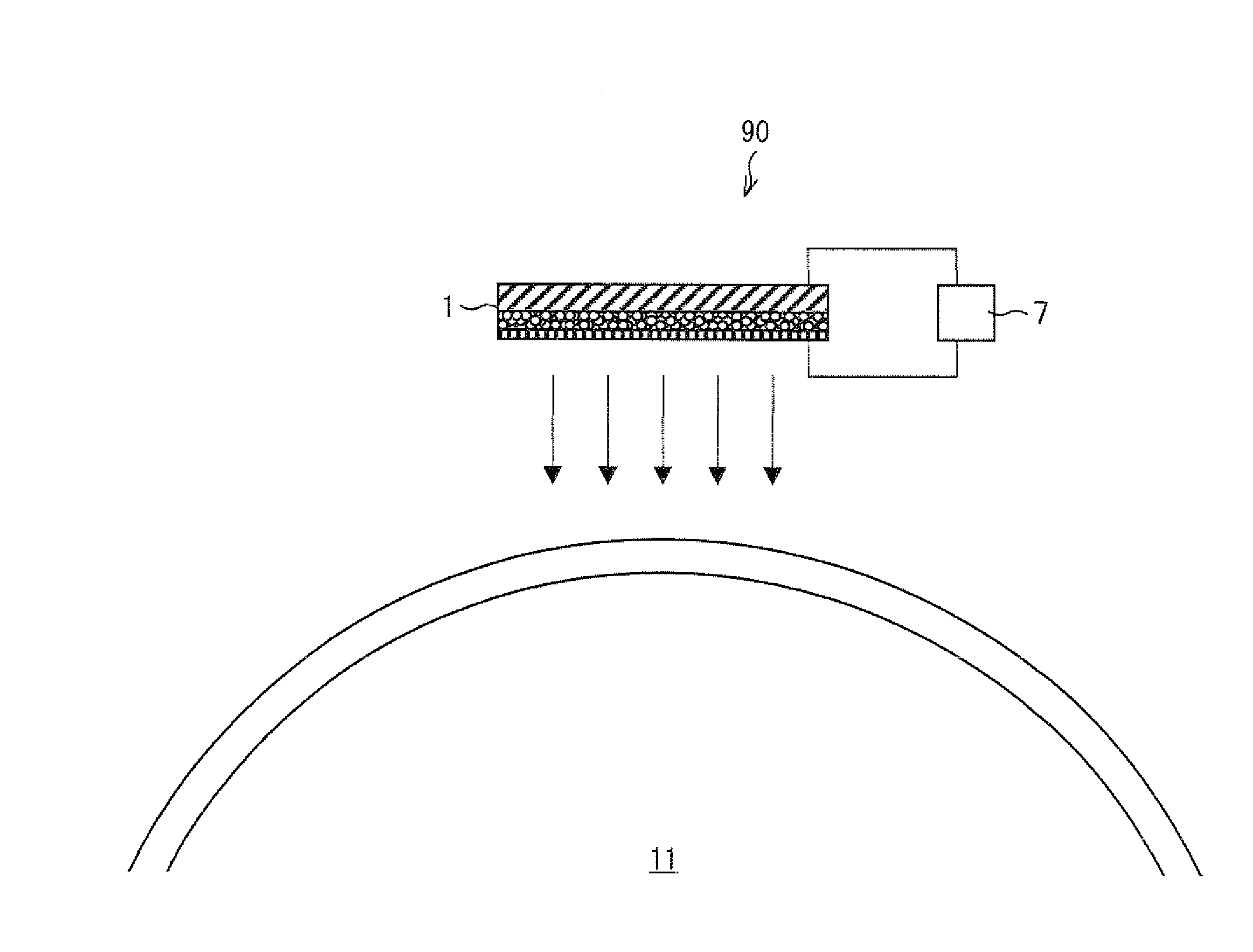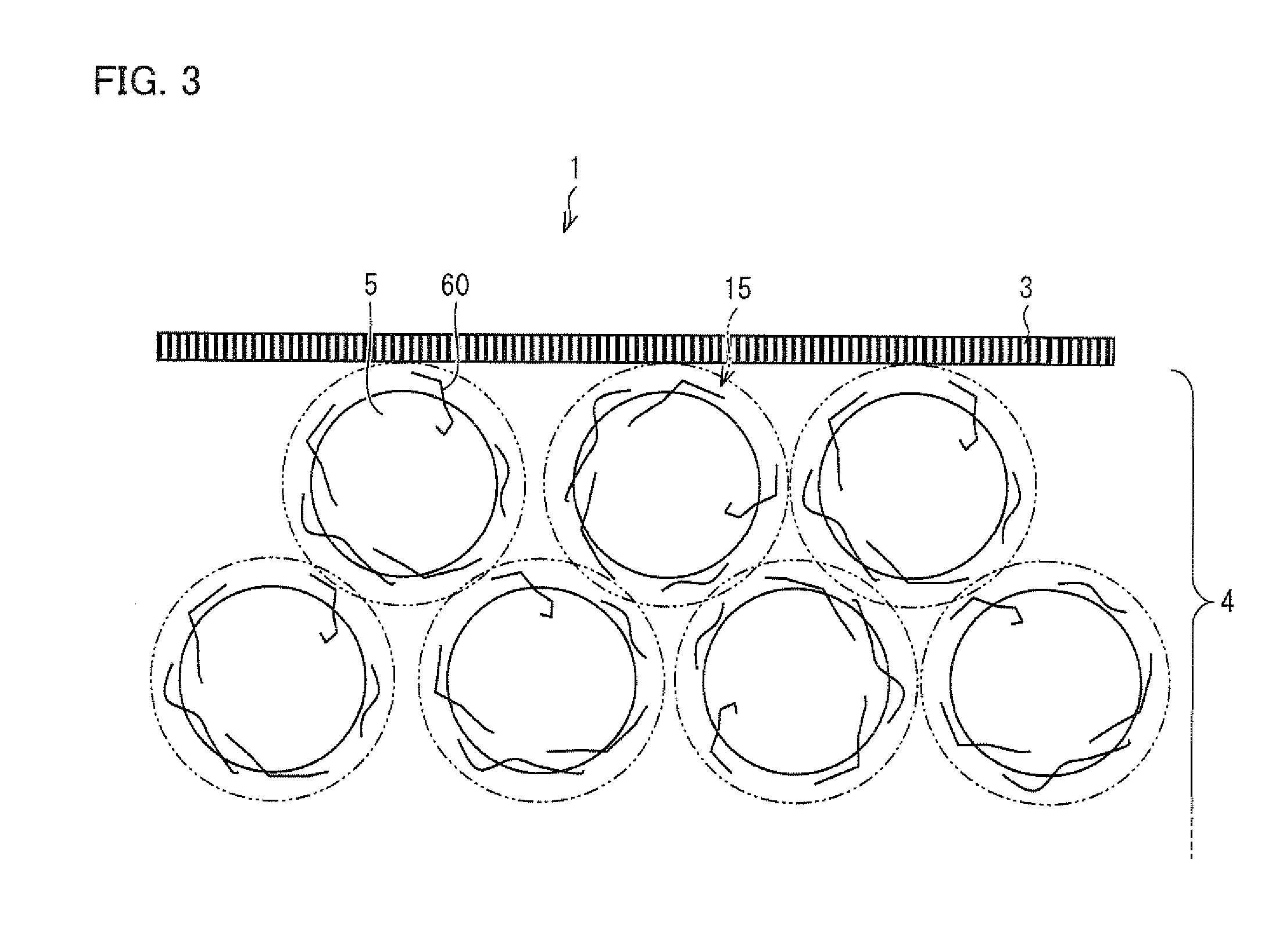Electron emitting element, electron emitting device, charging device, image forming apparatus, electron-beam curing device, light emitting device, image display device, air blowing device, and cooling device
a technology of electron emission and electron beam, applied in the field of electron emission element, can solve the problems of inability of thin-film electrode to secure electrical conductivity, uneven thickness of thin-film electrode, and inability to emit electrons through thin-film electrode, so as to achieve greater surface roughness of electron acceleration layer, reduce electron emission, and reduce the effect of electron emission
- Summary
- Abstract
- Description
- Claims
- Application Information
AI Technical Summary
Benefits of technology
Problems solved by technology
Method used
Image
Examples
embodiment 1
Configuration of Element
[0046]FIG. 1 is a schematic view illustrating a configuration of an electron emitting device 10 including an electron emitting element 1 according to one embodiment of the present invention. As shown in FIG. 1, the electron emitting device 10 includes the electron emitting element 1 according to one embodiment of the present invention, and a power supply 7. As shown in FIG. 1, the electron emitting element 1 of the present embodiment includes: an electrode substrate 2 as a lower electrode; a thin-film electrode 3 as an upper electrode; and an electron acceleration layer 4 sandwiched therebetween. Further, the electrode substrate 2 and the thin-film electrode 3 are connected to the power supply 7, so that a voltage can be applied between the electrode substrate 2 and the thin-film electrode 3 which are provided so as to face each other. The electron emitting element 1 applies a voltage between the electrode substrate 2 and the thin-film electrode 3 so that cur...
example 1
[0087]First, (i) 3 mL of toluene solvent, serving as a dispersion solvent, and (ii) 0.5 g of spherical silica particles (average particle diameter: 50 nm), serving as insulating fine particles 5, were supplied into a 10 mL reagent bottle. The reagent bottle was stirred by using an ultrasonic dispersion device for 30 minutes so as to disperse the spherical silica particles. Next, 0.125 g of silver nanoparticles made by Applied Nano Particle Laboratory Co. (average particle diameter of silver nanoparticles: 10 nm (including 1 nm of an alcoholate insulating film which coats the silver nanoparticles)), serving as conductive fine particles 6, were additionally supplied to the reagent bottle, and then the reagent bottle was subjected to the ultrasonic dispersion process as above. In this way, a fine particle dispersion solution “a”, in which the spherical silica particles and the silver nanoparticles were dispersed, was obtained. The ultrasonic dispersion process, which was carried out af...
example 2
[0091]An electron acceleration layer 4 was produced in a same manner as in Example 1, except that a period of the ultrasonic dispersion process after the silver nanoparticles were added was 30 minutes. A surface of the electron acceleration layer 4 of Example 2 was observed under the laser microscope, and found to have Ra of 0.2 μm.
[0092]In Example 2, a plurality of electron acceleration layers 4 were produced. Then, thin-film electrodes 3, each of which was made of gold and had the surface area of 0.014 cm2, were formed on surfaces of the respective plurality of electron acceleration layers 4. The thin-film electrodes 3 thus formed had film thicknesses of 5 μm, 10 μm, 15 μm, 30 μm, 35 μm, 40 μm, and 45 μm, respectively. As such, a plurality of electron emitting elements of Example 2 were obtained.
[0093]FIG. 5 illustrates measurement results, of electron emission current per unit area, measured for each of the plurality of electron emitting elements under vacuum of 1×10−8 ATM.
[0094]...
PUM
 Login to View More
Login to View More Abstract
Description
Claims
Application Information
 Login to View More
Login to View More - R&D
- Intellectual Property
- Life Sciences
- Materials
- Tech Scout
- Unparalleled Data Quality
- Higher Quality Content
- 60% Fewer Hallucinations
Browse by: Latest US Patents, China's latest patents, Technical Efficacy Thesaurus, Application Domain, Technology Topic, Popular Technical Reports.
© 2025 PatSnap. All rights reserved.Legal|Privacy policy|Modern Slavery Act Transparency Statement|Sitemap|About US| Contact US: help@patsnap.com



